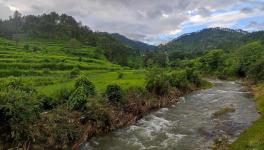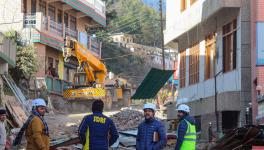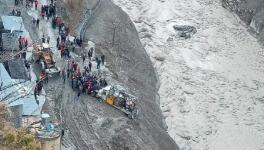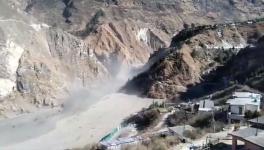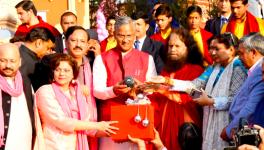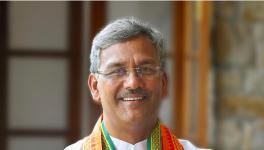Sand Mining Behind Bridge Collapses in Uttarakhand
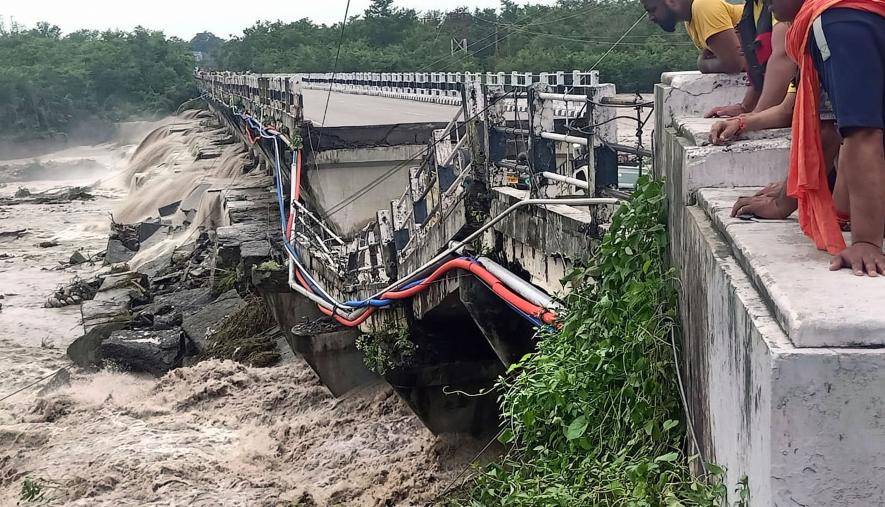
Image Courtesy: PTI
Uttarakhand could well be called India’s “calamity state”. Though well-endowed with natural resources, it is practically tottering on the brink, fighting one disaster after another. The latest is the collapse of several bridges, including the critical Dehradun-Rishikesh bridge on the Jhakan river, that left thousands of commuters scrambling for alternate routes.
The vital Dehradun-Rishikesh bridge connected the Jolly Grant airport with premier destinations in Uttarakhand. PWD engineers used to boast that this bridge would last over 100 years. Timely action by the NDRF could rescue those stranded on the collapsed bridge. The state government immediately attributed the bridge collapse to heavy rains, but residents of the nearby Rani Pokhari village blamed the collapse on rampant sand mining.
“We have made several complaints against sand mining to the authorities but no one listened to us,” said Vinod Rawat, an elderly farmer from the village.
Rani Pokhari is in the premier Doiwala constituency, from where former chief minister Trivendra Singh Rawat was elected MLA. The prestige associated with the constituency did not translate into strict action against the sand mining mafia that rules the roost in Uttarakhand.
Dr SP Sati, a leading geologist with HNB Garhwal University, says Uttarakhand government officials keep blaming cloud bursts for most disasters that affect the state. “They keep passing the buck. But muck is dumped in hundreds of our rivers due to excessive road building, increasing their volume and density. Illegal sand mining has exposed the pillars of all bridges, making them more vulnerable. As water flows at a much greater speed, several bridges have collapsed,” says Sati.
The bridge on the Song river that leads to Maldevta from Sahasradhara also collapsed. Again, authorities attributed it to heavy rainfall, but people who live in the vicinity of the bridge blame the sand mafia here too.
Raman Negi, who works in a restaurant near the bridge, says, “Not only is sand mining rampant, huge boulders from the riverside are taken in trucks by the land mafia and crushed for use in construction activities.”
Sand is necessary to stabilise bridges. Physicist Prof Vikram Soni of JNU says that sand, a porous material, absorbs water and helps reduce water flow. “When sand is removed from a river bed, the water flows at greater speed and volume. This increases pressure on the structure and could well prove a key cause in bringing it down,” he says.
Thirty-four PILs have been filed in the Nainital High Court against rampant sand mining. The court has taken cognisance of the problem, but little has changed. Those who dare raise their voice against sand and boulder mining get openly attacked. Leading environmentalist Dr Bharat Jhunjhunwala had his face blackened when he protested against this mafia. Activist Ajay Narain Sharma, who filed a PIL against sand mining, has received death threats and had to take police protection.
The problem is that the state authorities constantly devise new methods to continue mining because it is a business worth thousands of crores of rupees. The NGO SANDRP, which monitors dams and rivers across South Asia, has said that the Uttarakhand government has allowed mining within one kilometre of bridges and structures on all rivers, in blatant violation of a Nainital High Court order.
“It also increased the depth for mining from 1.5 to 3 metres of the river bed without any scientific study. Such brazen mining operations will only aggravate the flood situation,” says Bhim Singh Rawat of SANDRP.
Another strange twist to the environmental laws in the state is the announcement in January 2020 of a “River Training Policy” (RTP). The government has not devised this so-called training to assist the forest or irrigation department personnel in preserving rivers. Instead, as part of this “training”, silt, gravel and sand are extracted from the middle of hundreds of riverbeds. Since this redirects the flow of rivers to the centre, the government argues, it avoids erosion at the banks.
In other words, sand and boulder mining takes place in the rivers without any mining or environmental laws. Heavy machinery is allowed to dig up half the breadth of rivers, regardless of their width.
These relaxations of rules by the state government have seen mining and stone crushing extended to the Yamuna Valley, the Dakpathar Barrage and Paonta Sahib, the Khoh river, the Alaknanda river, Pindar river, Asan river in Dehradun, the Kosi river and other rivers.
“River ‘training’ is just a ploy to dredge the river bank, which creates huge cavities in the riverbed. They are also using it as a pretext to divert the course of the river. Many of these riverbeds are being plotted and sold to estates who are developing entire colonies on them,” says Dehradun-based Renuu Paul, who heads the NGO, Rajpur Community Initiative.
Certainly, bureaucrats are aware of what is going on in the state, but those who take action against the mining find their political bosses come out openly against them.
Last month, Harveer Singh, secretary of the nodal Mussoorie and Dehradun Development Authority, decided to take action against illegal encroachments and mining mafia. Overnight, Chief minister Pushkar Singh Dhami ordered his transfer.
In August, the Haldwani-Ranibagh bridge that connects Haldwani with Bhimtal, Almora and Ranikhet, collapsed. A senior PWD official complains that the inability of the state machinery to follow basic construction norms—soil testing, planning, studying the contours of the hills—is also responsible for the state of affairs.
A senior retired PWD official says, “The state government had decided to build a new bridge at the cost of Rs. 800 crores to replace the old Haldwani-Ranibagh bridge. Construction on the new bridge has started, but the new foundations are so close to the old bridge that it could have disturbed the foundations of the old structure.”
India's longest suspension bridge, the Dobra-Chanti bridge across the Tehri Dam, had developed cracks within nine months of its completion. The bridge was inaugurated in late 2020. At present, all traffic on this road has stopped, inconveniencing thousands who live across the dam.
There are also several questions around the Surydhar lake built on the Jhakan river as well. Says Paul, “The lake and a barrage were built at the insistence of former CM Trivendra Singh Rawat. Congress politicians led by former Congress chief Pritam Singh had alleged that Rawat developed the Suryadhar lake and got a small power station built for over Rs 70 crores to boost the value of land his wife owns next to the lake.”
She says that during end-August, engineers at the power station released excess water into the Jhakan river, which must have also affected the already weak foundations of the Rani Pokhari bridge.
“Since this is the first year of the functioning of this power station, the state authorities need to release details on the water flows from the barrage for July and August,” Paul says.
Environmentalists say that the repairs of these bridges will cost several thousand crores. For a state knee-deep in debt, strict action against the sand mafia is the only way out.
The author is a freelance journalist. The views are personal.
Get the latest reports & analysis with people's perspective on Protests, movements & deep analytical videos, discussions of the current affairs in your Telegram app. Subscribe to NewsClick's Telegram channel & get Real-Time updates on stories, as they get published on our website.










